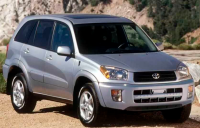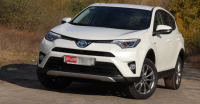The tire pressure rating for the 2020 RAV 4 depends on tire size and vehicle weight. Failure to meet the manufacturer's requirements will result in poor handling and rapid wear of the rubber or suspension parts.
The electronic tire monitoring system simplifies the check-up procedure, the driver needs to timely inflate the wheels or deflate the excess air.
The pressure in the car tires depends on various factors.
Article Content:
General Tire Reference Information for RAV 4 Tires
Table of normal tire pressures on the RAV 4
Is there a difference between 2020 and 2021 cars
2020 cars
2020 RAV 4 2021
Tire pressure monitoring system
Manual tire pressure check
Frequency of pressure checks
How to fit tires to your RAV 4
Tips
What's the optimal winter tire pressure?
Tire pressure on rough roads
Tyre pressure on a wet road
Recommendations
General background information about RAV 4 tires
Vehicles are shipped to customers with tires designed for summer use. The tread pattern allows you to move on dirt roads and light off-road, to overcome the deep mud on a standard crossover RAV4 is difficult.
Cars are designed to use rims with a diameter of 17 to 19″, in the U.S. market wheels are offered with a diameter of 20″ with tires that have a reduced profile height.
In the trunk there is a spare tire with a reduced width ("dokatka"), designed to move at speeds up to 80 km/h.
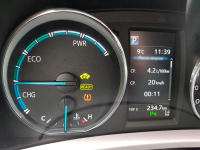
aluminum wheels with tubeless tires size 225/65R17, used on the basic configuration with a manual transmission;
Light-alloy wheels with tires of 225/60R18 standard for Comfort and Style versions;
aluminum disks with 235/55R19 tires, used on expensive Prestige and Prestige Safety versions.
Tire pressure chart for the RAV 4
Information on tire pressures can be found in the owner's manual. Additionally, there is a label located on the center pillar in the driver's door opening.
The label indicates the recommended pressures depending on the tire size and the loading of the crossover interior and luggage compartment. When operating the vehicle with a trailer, inflate the tires by 0.2 kgf/cm² and do not exceed a speed of 100 km/h.
Air leaks lead to:
increased fuel consumption due to increased rolling resistance;
reduced comfort;
impaired steering response;
Increased loads on the transmission units;
impaired driving safety;
reduced tire life or uneven wear and tear.
Is there a difference between 2020 and 2021 cars
Cars of related model years do not differ in design and have the same equipment options. Crossovers are equipped with tires of the same size, there are cars with rubber brands Bridgestone, Dunlop, Continental.
Tire companies are official suppliers to the conveyors, and also offer tires for later replacement.
2020 Cars
Tires sized 225/65R17 102H, 225/60R18 100H and 235/55R19 101V were offered for 2020 model year crossovers. The factory-recommended pressure is 2.3 kgf/cm² and is independent of tire load and dimensions.
When driving with a trailer, tires should be inflated by 0.2 kgf/cm² (driving speed up to 100 km/h). The base version with 17″ rims used the spare tire size T165/80D17 104M.
Other versions had a T165/90D18 107M wheel in the trunk. Both types were designed for a working pressure of 4.2 kgf/cm².
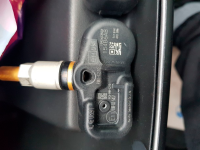
The tire pressure of 2.3 kgf/cm² in a 2020 car.
2020 RAV 4 2021
Recommended pressures for crossovers RAV4 2021 model year are shown in the table. Cars for the Market are equipped with a small spare tire. For other regions of sales an emergency tire repair kit and electric compressor are available.
Size Pressure in front grades, kgf/cm² Pressure in rear grades, kgf/cm²
225/65R17 102H 2.3 2.3
225/60R18 100H 2.3 2.3
235/55R19 101V 2.3 2.3
T165/80D17 104M 4,2 4,2
T165/90D18 107M 4,2 4,2
System for controlling pressure in ramps
Some vehicles are equipped with an automatic pressure control system with a control indicator in the instrument cluster (only available with a 7″ display).
TPWS direct sensors are used for detecting air leaks, which transmit information via radio-frequency channel and do not require charging or replacing batteries.
Sensor
When air leakage occurs, the electronics detects the discrepancy and turns on the control light in flashing mode, after 60 seconds of driving the light goes out.
After replacing or repositioning the tires, the owner must initialize the system:
Stop the vehicle, stop the engine, and adjust the tire pressure to the prescribed value.
Turn the ignition on, and then press the directional arrow icon buttons on the steering wheel, switching the menu sections on the screen in the instrument cluster.
Once you reach the gear symbol section, press the steering wheel buttons with the up and down arrow icons.
After the message "Autosetup" is displayed on the screen, press and hold the button. Press and hold down the button with the Ok icon.
Release the button, use the steering wheel controls to select the section labeled TPWS, and then press the Ok button again.
Select the item labeled "Set Pressure", press and hold the Ok button to record the current parameters. The control lamp should flash 3 times, confirming that the data is stored in the memory. During further operation the system will be guided by the programmed pressure.
The owner can upgrade the vehicle by installing radio frequency sensors on the nipples. The signal is picked up by the control unit located in the car.

Information about the tire pressure is shown on the display, there is an audible alarm of air leakage. The manufacturer does not install such a system in the factory, but many competitors offer a similar option (for example, the indication is present on the Volkswagen Tiguan second generation).
Readings on the ramp pressure indicator.
Checking tire pressure manually
To determine the air pressure in the tires will require a pressure gauge with a special nozzle, which is mated to the nipple. Classic products are equipped with an arrow analog gauge, there are gauges with an LCD display and mechanical indicators.
All devices are designed for year-round operation, the measurement error depends on the manufacturer and is in the range of 0.1 ... 0.2 kgf/cm². The pressure can be determined at the tire inflation stations located at the large network petrol stations.
The test is carried out on cold wheels, the vehicle must be stationary for at least 3 hours. It is allowed to check after a distance of no more than 1.5 km (a short distance does not allow the tires to warm up).
When testing the pressure immediately after a long drive in the city or on the highway, the pressure gauge will show overpressure. It is not necessary to bleed the air, because after cooling the parameter will return to normal.
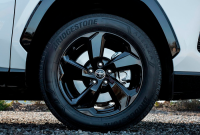
A short description of the check algorithm:
Unscrew the decorative cap of the nipple.
Carefully place the pressure gauge tube against the nipple tip.
Determine the pressure, and then replace the cap. It is not advisable to operate tires without protective guards on the valve, as dirt entering the valve causes corrosion and air leakage.
Manually check the pressure of the car tires.
Frequency of Pressure Checking
The manufacturer recommends checking the tire pressure at least once every 2 weeks (regardless of the conditions and intensity of vehicle use).
Regular testing allows timely detection of air loss and elimination of the cause. At the same time it is recommended to inspect the tread, which should not show signs of uneven wear. Damage to the racetrack indicates improper wheel alignment or damage to the suspension arms.
Choosing the right tires for your RAV 4
When selecting tires for the crossover, consider:
allowable dimensionality;
speed index;
type of tread;
seasonality.
Tires should be replaced when deep damage exposing the cords is detected. Do not operate tires with the tread worn down to the indicator strip.
Some owners are forced to install new tires after punctures that cannot be repaired with standard methods. Toyota does not recommend the use of a set of tires more than 6 years (regardless of mileage), because the rubber loses elasticity.
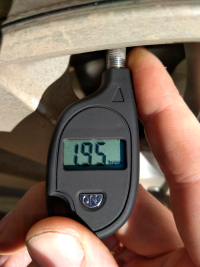
For winter tires, the allowable tread depth is 4 mm, with further wear the braking efficiency decreases.
Do not use tyres made by different manufacturers, or tires of different sizes or tread patterns.
Do not use tyres with different tread pattern heights. Tires with different designs (e.g., diagonal and radial) or those designed for different operating conditions must not be fitted at the same time. Differences in rubber characteristics impair acceleration and braking stability and may lead to accidents.
Tips
What is the optimal pressure for winter?
For any time of the year the pressure values of the tires used will be the same, much more important is the presence/absence of winter tires. The pressure should be adjusted on cold tires in the environment used, not in a warm garage. It is important to understand that a sudden change in temperature can change tire pressure by 0.2-0.4 bar.
Tire pressure for off-road use
When driving off-road, it is necessary to lower the pressure in the tires used by 0.2-0.3 atmosphere of the specified pressure for Toyota Rav4, then the wheels will act as tracks, which will increase the off-road capability of the SUV.
Pressure on the wet road
When driving on a wet track, there is a problem of improper distribution of forces at the point where the tire contacts water. In such situations, it is necessary to monitor the stability of tire pressure more carefully.
Do not intentionally lower or overinflate a tire. Because of the reduced pressure, the tires will have weaker contact in the central part of the tread. If the wheels are overinflated, weak contact will be present in the shoulder areas, which also greatly reduces aquaplaning resistance.
Recommendations
It is important to check tire pressures only when the temperature is between +10 and +15°C.
Tire pressure cannot be read by eye, always use a tire pressure gauge.
The warming of the tire by sunshine can considerably affect the tire pressure, bear this in mind when measuring on each side of the car.
Pressures on all-season tires decrease as the weather gets colder, so be sure to inflate the tires as the season changes.
When you use the pump at the gas station, check the final pressure with your pressure gauge, filling pumps are usually wrong due to their poor condition.
The range of pressures indicated on the sidewall of the tire is the maximum allowable pressure for its cold condition.
If you do decide to keep your tires at maximum pressures, never exceed the pressures listed on the tires themselves.


